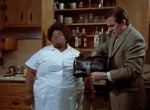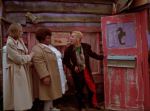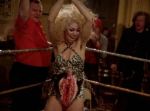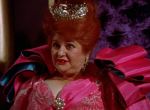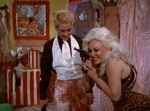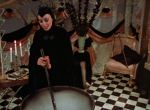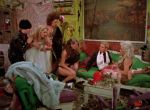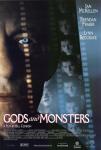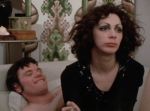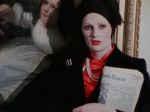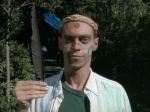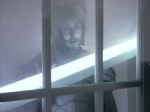
Today’s cinema adventure: Prick Up Your Ears, the 1987 feature by director Stephen Frears about the short life and brilliant career of English playwright Joe Orton, whose rise to success in the theatrical scene of mid-sixties London was cut short by his brutal murder at the hands of his long-term partner, Kenneth Halliwell. Based on the biography of the same name by John Lahr, the film approaches Orton’s life with a macabre sense of humor much like that found in his plays, and features superb performances by Gary Oldman and Alfred Molina (as Orton and Halliwell, respectively); it was greeted by enthusiastic reviews by critics upon its release, though its popular appeal was, naturally, somewhat limited by its subject matter- particularly outside of Britain, where Orton’s name is less familiar. Nevertheless, it achieved relative box office success due to the wave of interest in British imports during the eighties, and, along with the previous year’s Sid and Nancy, helped to secure Oldman’s place as one of the most promising- and sought-after- young actors of the decade.
The screenplay of Prick Up Your Ears– penned by Alan Bennett, another renowned playwright whose own career dates back to the same era as Orton- is expanded from the book upon which it is based by the inclusion of author Lahr as a character, using his research and writing of the acclaimed biography- particularly through his interviews with Orton’s agent and close friend, Margaret Ramsay- as a means of framing the story. This device allows for a non-linear exploration of Orton’s life, centered around the notorious murder-suicide which brought it to an end, that reveals key moments of the playwright’s history as it makes a more in-depth examination of his relationship with Halliwell. In this manner we are given a narrative which chronicles Joe’s life from his working class youth in Leicester, where he pursues an interest in drama despite the intentions of his parents to educate him for a career as an office worker. He manages to earn a scholarship to the Royal Academy of Dramatic Arts in London, where he meets and becomes involved with Halliwell, an older student attending the school through a small inheritance. The two take a flat together, and begin an unsuccessful, decade-long attempt to collaborate as writers; Joe also indulges in an almost daily habit of anonymous sexual encounters in public places- mostly men’s restrooms- and writes about them in his diary. The two are eventually arrested (for defacing library books) and serve short jail terms, during which Joe writes- on his own- a play that he submits to BBC Radio; it is accepted and produced, marking the beginning of his rise to fame- and also of the deterioration of his relationship with the jealous, insecure Halliwell. As Joe becomes the toast of the London theatrical world, with smash hit plays and an offer to write a screenplay for The Beatles, Ken becomes increasingly morose and frustrated at being kept out of the spotlight, even after the couple spends a lengthy vacation in Morocco; finally, no longer able to face a life lived in the shadow of another’s success, Ken kills Joe as he sleeps, beating him savagely to death with a pall peen hammer, then takes an overdose of pills to follow his lover into death.
As a rule, I generally find film biographies to be somewhat unsatisfying; though, at their best, they can be a showcase for tour-de-force acting, superb direction and magnificent scenic and costume design, at their core they often suffer from an impossible desire to somehow encapsulate a person’s entire life and essence into a two-or-so-hour time frame, or to interpret their motivations and actions in a way that casts them in a particular light. In truth, of course, even the strictest documentary cannot avoid inserting a subjective viewpoint, but biopics, at their most banal, make a deliberate effort to deify- or vilify, in some cases- their subjects, resorting to the manipulative tactics of melodrama and completely ignoring or altering facts in order to tell a more “satisfying” story. The most artistically successful examples of this genre are those that use their subject as a means to communicate ideas about universal experience, or simply to entertain us with a little-known story from our past that may, hopefully, encourage us to learn more on our own. Prick Up Your Ears does both.
Frears’ movie is blessed with the participation of numerous talented individuals with a clear affection for- and familiarity with- Joe Orton and his work, and they have here taken pains to create a picture of this influential and iconoclastic figure that presents his life in a manner that is, if not 100% factually accurate, at least true to his own vision of the world in which he lived. Much of this is made possible by the use of his diaries as a source of information, both for the original published biography and for the screenplay; through this remarkable document, which has since been published in its own right, we are granted unprecedented access to Orton’s most private thoughts and experiences- most obviously his frequent and adventurous sexual escapades, recorded with particular pride and relish- and allowed to see the author’s own perspective on himself and his life. Of course, that perspective- dark, cynical and full of deliciously salacious humor- comes as no surprise to those familiar with Orton’s plays, brilliant farces which skewered traditional theatrical forms while undermining and exposing the hypocrisies of social convention and the ugliness hidden behind the all-important facade of so-called “decency.” Bennett writes the story of Joe and Ken as if it were itself penned by Orton, peppering the dialogue with lines that seem as if they were lifted directly from his writing and presenting the people that surround the two central figures as if they were characters in one of his plays. This approach makes for a truly Ortonesque experience of Orton himself, but it also has the shrewdly observed added effect of showing how the playwright drew inspiration from the people and circumstances of his real life; seeing the world as Joe himself saw it makes it clear that his particular genius came simply from transcribing what he saw around him into his work. The farcical absurdities of his real-life experience fed his writing, and the fact that they are here no less believable for their absurdity suggests that very little exaggeration was required to translate them to the stage.
Joe’s perspective is not, however, the only one brought into play in Bennett’s and Frears’ vision of his life. The film is also, of course, heavily informed by Lahr’s biography, which casts a more detached and empirical eye on the playwright- in particular on his relationship with Halliwell- and allows us to see him in a more humanistic light, perhaps, than that toward which he might have been inclined. This does not mean, however, that Prick Up Your Ears takes any kind of moral stance on Joe- or Ken, for that matter- in its depiction. On the contrary, the movie takes pains to portray the pair as they were, without imposing judgment, and allows us to draw our own conclusions; though their end was undeniably tragic, and a good deal of the film can be seen as an examination of the factors that led up to it, there was more to Joe and Ken’s connection than their horrific final destiny, and Frears and Bennett make sure we see as many other facets as possible of their lives together. Finally, in exploring their relationship, and the changing dynamics created by collaboration, success, fame, and failure, the movie also explores the way these factors are reflected in John Lahr’s marriage, and by extension, suggests certain observations about the nature- and the pitfalls- of mixing creative endeavor with romantic attachment.
Of course, for most people who have even heard of Joe Orton- outside of theatrical and literary circles, of course, and often even there- the lurid and scandalous circumstances of his death are far better-known than his work. Frears and Bennett make certain that their audience knows, right from the start, that this event is the central focus of the film, a sort of epicenter from which everything else radiates. The movie opens with a glimpse into the final, terrible moments, followed by the discovery of the bodies and the subsequent invasion of the bloody scene by the authorities. We are, however, given only a peek, so that for the rest of the movie, we are left to hope for the kind of graphic, gruesome detail we want to see- and we do want to see it, as Joe himself would likely understand better than anyone. Indeed, it is this gory revelation that the director uses as bait, like a carrot dangling before us as we make the journey through Joe’s life and times, motivating us to stay with the story so that we can get that nasty payoff at the end; and Frears gives it to us, alright, in a harrowingly real depiction of the brutal murder and its aftermath that is likely to affect even the most hardened viewer and leave nightmarish, lingering visions for some time afterwards. Yet even this dose of cold, hard realism in the midst of the film’s wacky theatricality is in keeping with its dedication to the flavor and spirit of Orton’s work; his writing, for all its juxtaposed sophistication and irrepressible rude-boy naughtiness, carried at its center an acute awareness of the ugliness of human experience, an ignoble convocation of bodily functions- sexual, scatological, and otherwise- which makes ludicrous all attempts to dignify it with pretense or affectation, and is made all the uglier by the mean-spirited cruelty with which we treat each other. Orton’s brutal death at the hands of his lover- the ultimate bodily function as a result of the ultimate cruelty- serves as a reminder of the nihilistic truth of which he was a champion.
The darkness that underlies all the glib merriment, though, is only a part of the Orton mystique; though he was bent on exposing the inherent nastiness of the human condition, he also derived a great deal of fun from it. He was a literary rebel, using his wit as a weapon against the stifling social conventions that made him feel like an outsider; he was a master marksman, and his wicked skills gave voice to a new generation that despised the stodginess of their moribund culture as much as he did. More to the point, though, he had fun doing it; Joe Orton was all about having fun, an obvious fact to which his hedonistic lifestyle plainly attested, and the glee he felt in skewering the pompous and the conventional was almost certainly his main (if not only) reason for doing it. That glee comes across in his writing, and is readily shared by audiences who see his plays, which are still frequently performed today. It also comes across in Prick Up Your Ears.
Aside from Bennett’s screenplay, the movie benefits greatly from Frears’ steady, assured direction. Noted for his skill in handling stories about socially isolated people adapting to new circumstances, a theme which runs through most of his films from My Beautiful Laundrette to The Queen, he shares with Orton an origin in Leicester, a fact which no doubt helped to solidify his understanding of and connection to the material here, and has a long collaborative history with Bennett. He crafts his film with a perfect balance of the cinematic and the theatrical, creating a blend of gritty realism and heightened style enhanced by flourishes from both media; he also exhibits a showman’s knack for storytelling, managing to form a cohesive and unified narrative which engages our interest and remains easy to follow throughout its non-linear structure. He is aided by meticulous production design which smartly re-creates the atmosphere of London in the swinging sixties, contrasting it with the mundane and utilitarian environment of working-class Leicester, as well as with various institutional settings and scenes of the seedy sexual underworld that arise within Joe’s checkered story.
Most importantly, though, Frears’ film is blessed with the magnificent performances of its two stars. Oldman and Molina are electrifying, offering layered, chameleonic portraits of the cheeky, good-natured rude boy and his arch, affected lover that reveal the traits, both positive and negative, in both without sentimentality or comment. Oldman truly seems to channel his subject, not only bearing a strong physical resemblance to “the most perfectly-developed playwright of his day” but capturing the particular seductive swagger that is evident in photos and the few films that survive of Orton; it’s not mere mimicry, however, for he also infuses the doomed writer with a palpable humanity that allows us to truly involve ourselves with him emotionally, and understand why even those who thought him shocking and indecent found him irresistible and endearing, nonetheless.. The more difficult task, though, is Molina’s; he gives us Halliwell in all his insufferable pomposity, and takes us through his deterioration without varnish, and yet he, too, finds the human element here that makes poor Ken as much a tragic figure as Joe- a man of intelligence, wit, and emotional generosity, clearly affected by psychological issues that might have been more readily understood and addressed in our modern day, but which, at the time, were subject to as much stigma and shame as his homosexuality. Molina gives a heartbreaking performance, and it is largely thanks to him that Prick Up Your Ears succeeds in capturing the full ironic scope of the Orton-Halliwell saga. In the third principal role, that of legendary theatrical agent Margaret “Peggy” Ramsay, Vanessa Redgrave is, as always, superb; her glittering charm and sophistication light the screen, but she also gives us a clear view of the character’s opportunistic and manipulative aspects- she, like Joe, is “getting away with it,” but that doesn’t make her any less likeable, in the end. Redgrave’s presence also adds an important pedigree that links the film directly to the world it portrays; she is, of course, a member of one of Britain’s great acting dynasties, and was deeply immersed in the London theatrical scene during the era in which Orton was active. This connection is, perhaps, immaterial in terms of practical application to the execution of the film, but it does contribute a sort of authenticity to the proceedings that does seem, to me at least, to have an effect, however intangible, on its sense of validity. Wallace Shawn (another renowned playwright) uses his familiar nerdy intellectual persona to good effect as biographer Lahr, Frances Barber has a touching turn as Orton’s sister, Leonie, and Janet Dale provides a memorable illustration of classic Ortonesque caricature as Joe and Ken’s doting landlady. In smaller, cameo-style roles, familiar English character actors such as Julie Walters, Richard Wilson, and Margaret Tyzack bring their considerable talents into the mix, contributing much to the overall perfection of tone and style that makes Prick Up Your Ears such a delightful marriage of film and theater influences.
It’s pretty obvious, by now, that Prick Up Your Ears is a highly recommended cinema adventure, as far as I am concerned. The fact that I am personally a great admirer of Joe Orton is really not a factor in my enthusiasm for the film, except in the sense that my expectations of any work dealing with him are stringently high, making Frears’ movie all the more impressive to me for its worthiness to the subject matter. I am confident that this smart, stylish and accessible piece will be an enjoyable experience for almost any mature viewer, whether they are fans of Orton or have never heard of him; even if you have no interest whatsoever in theatrical history, British or otherwise, Prick Up Your Ears offers up a fascinating story that is no less entertaining for being true. That said, it should be mentioned that it is a film in which homosexuality plays an integral part, and it does include extensive, if not graphic, depictions of gay sexual behavior; if such matter is uncomfortable for you, for whatever reason, then consider yourself warned. This subject brings up an important point concerning Prick Up Your Ears, and indeed about Orton himself; though the playwright was not overtly involved in any form of struggle for gay rights- his death took place two years before the Stonewall riots in New York, after all- and though the film does not address or take any sort of stance on the issue, the subject is inseparably woven into the fabric of this story. As gay men living in a society that criminalized and ostracized their kind, Orton and Halliwell lived their lives as disenfranchised outcasts, forced to suppress their true nature in order to avoid persecution and even imprisonment; though it was the older Halliwell who helped Joe to accept and embrace his sexuality, it was the younger man who would go on to live an audaciously open life in the face of societal disapproval, and despite his efforts to bring Ken along, he was unable to overcome the obstacles of shame and insecurity that would eventually result in the tragic conclusion of their love story. Each man took a different direction in reconciling his sexual identity with cultural expectation, and though this was clearly not the only factor in the murderous frenzy that took their lives, it is beyond question that it played a substantial part. In this way, though on the surface it seems only a parenthetical circumstance that defines the two central characters, homosexuality- or to be more specific, the rejection of homosexuality by so-called “normal” society- is the issue at the core of Prick Up Your Ears. Those with a more militant bent might wish that Bennett and Frears had taken a more direct assault on the social injustice that marked the cultural landscape of Orton and Halliwell’s England; but the story, like Joe’s plays- and Joe himself- speaks for itself. Joe Orton chose not only to be open about who he was, but to flaunt it; he simply was, and the strength of that assertion was sufficient to make him an icon. Prick Up Your Ears is a celebration of that bold spirit, and it tells Joe’s story in a voice very much like his own; that makes it not only a testament to the lasting mark he made in his short life, but also a bloody good time.
http://www.imdb.com/title/tt0093776/?licb=0.2046471543502929












































































